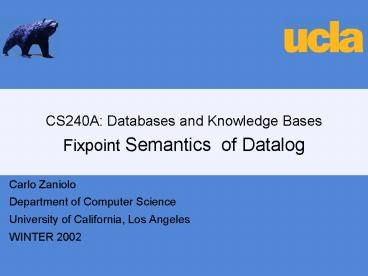CS240A: Databases and Knowledge Bases Fixpoint Semantics of Datalog - PowerPoint PPT Presentation
Title:
CS240A: Databases and Knowledge Bases Fixpoint Semantics of Datalog
Description:
Fixpoint Semantics of Datalog Carlo Zaniolo Department of Computer Science University of California, Los Angeles WINTER 2002 Three Equivalent Semantics Model ... – PowerPoint PPT presentation
Number of Views:31
Avg rating:3.0/5.0
Title: CS240A: Databases and Knowledge Bases Fixpoint Semantics of Datalog
1
CS240A Databases and Knowledge BasesFixpoint
Semantics of Datalog
- Carlo Zaniolo
- Department of Computer Science
- University of California, Los Angeles
- WINTER 2002
2
Three Equivalent Semantics
- Model Theoretic describing what facts hold true
because of the given facts and rules. - Proof Theoretic using SLD-resolution
- Fixpoint Semantics. Defined as the least
fixpoint of the transformation defined by the
rules. - For positive programs (I.e., programs without
negated goals) all three semantics are-well
defined and equivalent. Here we will cover only
3. - For programs with negated goals things are more
complex, different semantics are possible and
equivalence might not hold any longer. Here we
will only consider stratified negation.
3
Example
- anc(X, Y) parent(X, Y).
anc(X, Z) anc(X,Y),
parent(Y,Z). - parent(X, Y) father(X, Y).
parent(X, Y) mother(X, Y). - mother(anne, silvia).
mother(silvia, marc). - A bottom-up derivation to derive facts
that are true. - Step1 mother(anne, silvia), mother(silvia,
marc). - Step2 mother(anne, silvia), mother(silvia,
marc), parent(anne, silvia),
parent(silvia, marc). - Step3 those in step 2 anc(anne, silvia),
anc(silvia, marc). - Step4 those in step 3 anc(anne, marc).
- Step4 those in step 4 only---we have reached
fixpoint.
4
Herbrand Universe and Ground Instanceof program P
- The Herbrand Universe for P, denoted UP, is
defined as the set containing (1) the constants
in P and (2) the terms recursively constructed
by letting the arguments of functions be elements
in UP. - For the example program UP anne, marc,
silvia. - Ground version a rule r ground(r). This is the
set of ground instances of r --i.e., all the
rules obtained by assigning to the variables in
r, values from the Herbrand universe UP. - E.g. from the previous program take parent(X,
Y) mother(X, Y). Since there are 2 variables in
this rule and UP 3, then ground(r) consists of
3 3 rules - parent(anne, anne) mother(anne, anne).
- parent(anne, marc) mother(anne, marc).
- ...
- parent(silvia, silvia) mother(silvia,
silvia).
5
Semantics of a positive program P as the least
fixpoint of its Immediate Consequence Operator TP
- The ground version of a program P, denoted
ground(P), is the set of the ground instances of
its rules - ground(P) ground( r) r Î P
- The Immediate Consequence Operator TP
- TP(I) A Î BP r A A1,...,A nÎ
ground(P), A1,...,An Í I - The TP operator can be implemented using the
relational algebra equivalent of the relational
rules. - The fixpoint equation I TP(I)
- The solutions of this equations are called
fixpoint for TP - When we have several solutions we can find the
minimal ones and the least ones (according to Í
) - For a positive program P the least fixpoint of
TP exists and is denoted lfp(TP) - lfp(TP) defines the meaning of P.
6
Computation of TP
- Powers of TP TP 0 ( I ) I
- ¼
- TP n1 ( I ) TP ( TP n (I) )
- Moreover, with w denoting the first limit
ordinal, we define - TPw (I) È T n (I) n ³ 0
- Powers of TP starting from the empty set I.e.
from I Æ - Theorem If P is a positive program then lfp(TP)
TPw (Æ) - NB the monotonicity of TP is critical for the
existence of lfp(TP) and its efficient
computation (next slide).
7
Computing TPw (Æ)
- Theorem The successive powers of TP, form an
ascendingchain I.e. TPn (Æ) Í TP n1 (Æ). - Proof by induction
- Base Æ TP0 (Æ) Í TP1(Æ),
- Induction If TPn-1 (Æ) Í TPn (Æ) then TPn
(Æ) Í TPn1 (Æ) - Indeed, TPn(Æ) TP ( TPn-1(Æ)) and TPn1(Æ)
TP ( TPn(Æ)) - And the conclusion follows from the monotonicity
of TP - Corollaries TPk(Æ) Èn k TPn (Æ)
- if TPk1(Æ) TPK (Æ) then TPK (Æ) TP
(Æ)w - Computation start from the empty set, and repeat
the application of TP until no new atoms are
obtainedI.e., the n1-th power is identical to
the n-th one (if such condition never occurs then
we have an infinite computation).






























